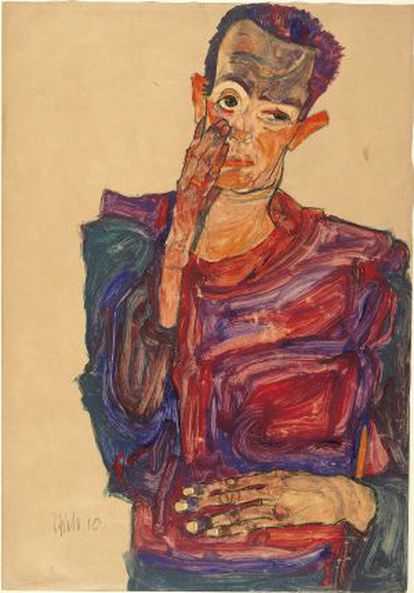Distortion effect
The disturbing drawings of expressionist Egon Schiele

The disquieting watercolor, gouache, ink, charcoal and chalk-scrawled figures of the great Viennese expressionist Egon Schiele (1890-1918) have just gone on show at the Guggenheim Bilbao as part of the events celebrating the museum's first 15 years.
More than 100 works from the archive of the Albertina museum in Vienna, holder of the biggest collection of works by the artist in the world, feature in the exhibition, which offers an in-depth examination of the conceptual, formal and thematic evolution of his work.
Schiele is an artist who goes on raising questions among historians and critics -- notably what might have happened if he had not died from Spanish flu aged 28, just as he was starting to enjoy genuine star status in Viennese artistic circles. This collection of works executed on low-quality paper, backed by rough wood, sums up the legacy of an artist who exuded uneasiness and non-conformism and learned to break the rules of color and line after studying the work of Vincent van Gogh and Edvard Munch.
It's an exhausting journey, covering the academic training that he quickly abandoned; his initial love affair with Viennese modernism and the Secession movement led by Gustav Klimt, his teacher and mentor; and the subsequent break that led him into the wild territory of expressionism. A narcissist who insisted he was his own best model, he represented himself with a thousand different faces in countless self-portraits.
He also had a passion for spiritualism, photographs of ghosts and pictures of schizophrenics and -- no doubt following the teachings of his compatriot Sigmund Freud -- he saw it as his non-negotiable mission to dive into the bottomless pits of sexual drives. This included making explicit drawings and paintings of sex, even involving children. "It is incredible; you have forgotten how sex fascinated us when we were kids," he told those who attacked him for painting naked children in his studio in the small town of Krumau, to where he fled to escape the asphyxiating and conservative Viennese society of the era.
The show also features drawings and watercolors from his prison series, made after he was locked up for three weeks after being convicted of exhibiting erotic drawings where children could access them. It was a traumatic experience for the fun-loving Schiele (despite what his self-portraits depict), but it could have been a lot worse. The initial charge (which was ultimately thrown out) had been "kidnapping and abusing minors" after a naval official reported him and his wife for taking his 13-year-old daughter, one of the girls who modeled for him, to Vienna.
Egon Schiele. Until January 6 at Guggenheim Bilbao, Avenida Abandoibarra 2, Bilbao. http://schiele.guggenheim-bilbao.es










































